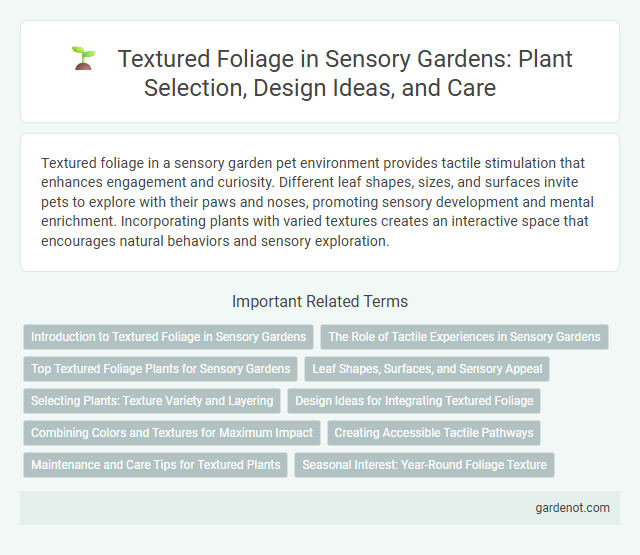Textured foliage in a sensory garden pet environment provides tactile stimulation that enhances engagement and curiosity. Different leaf shapes, sizes, and surfaces invite pets to explore with their paws and noses, promoting sensory development and mental enrichment. Incorporating plants with varied textures creates an interactive space that encourages natural behaviors and sensory exploration.
Introduction to Textured Foliage in Sensory Gardens
Textured foliage plays a vital role in sensory gardens by enhancing tactile experiences and visual interest. Plants such as lamb's ear, with its soft, velvety leaves, and ornamental grasses, featuring fine, wispy blades, provide contrasting textures that stimulate touch and sight. Incorporating diverse leaf surfaces promotes engagement and supports therapeutic benefits for visitors with sensory processing needs.
The Role of Tactile Experiences in Sensory Gardens
Textured foliage in sensory gardens plays a vital role in engaging tactile experiences that stimulate the sense of touch and enhance sensory exploration. Varied leaf surfaces, such as velvety lamb's ear, rough lamb's tail grass, and smooth hosta leaves, invite visitors to feel and connect with nature, promoting sensory integration and mindfulness. The tactile interaction with diverse plant textures supports sensory development, especially for children and individuals with sensory processing challenges.
Top Textured Foliage Plants for Sensory Gardens
Top textured foliage plants for sensory gardens include lamb's ear (Stachys byzantina), known for its soft, velvety leaves that invite touch, and coral bells (Heuchera), which offer vibrant colors and ruffled leaf edges. Japanese painted fern (Athyrium niponicum) provides intricate, feathery foliage that enhances visual and tactile experiences. Incorporating a variety of textured foliage enriches sensory engagement by stimulating touch and sight in garden spaces.
Leaf Shapes, Surfaces, and Sensory Appeal
Textured foliage in sensory gardens offers diverse leaf shapes and surfaces that engage multiple senses, enhancing tactile and visual stimulation. Varied leaf textures such as smooth, fuzzy, or serrated provide unique sensory experiences for visitors, promoting interaction and exploration. Selecting plants with contrasting foliage shapes and tactile qualities enriches the garden's sensory appeal and supports therapeutic benefits.
Selecting Plants: Texture Variety and Layering
Selecting plants with diverse textured foliage enhances sensory engagement in a sensory garden by creating tactile and visual interest. Incorporating a variety of leaf shapes, sizes, and surface qualities, such as smooth, fuzzy, or serrated textures, promotes deeper interaction and stimulates multiple senses. Layering these plants in different heights and densities maximizes sensory impact and supports accessibility for all visitors.
Design Ideas for Integrating Textured Foliage
Incorporate a variety of textured foliage such as lamb's ear, ornamental grasses, and ferns to create a multi-sensory experience in your sensory garden. Layering plants with contrasting leaf shapes and surfaces enhances tactile engagement and visual interest, supporting sensory stimulation for all ages. Use pathways lined with soft, velvety leaves or rough, crinkled foliage to guide visitors through diverse sensory zones.
Combining Colors and Textures for Maximum Impact
Textured foliage enhances the sensory garden experience by blending diverse leaf shapes and surfaces that stimulate tactile exploration. Combining vibrant colors such as deep purples, bright greens, and rich reds with contrasting textures like smooth, velvety, or spiky leaves creates a visually captivating environment. Strategic layering of these elements maximizes impact, encouraging engagement and promoting a calming, immersive natural space.
Creating Accessible Tactile Pathways
Textured foliage enhances sensory gardens by providing a rich tactile experience that engages visitors of all abilities. Incorporating varied leaf shapes, sizes, and surfaces along pathways ensures accessible tactile stimulation, supporting inclusive design principles. Strategic placement of these diverse plants facilitates wayfinding and encourages exploration through touch for individuals with visual impairments.
Maintenance and Care Tips for Textured Plants
Textured foliage in sensory gardens requires regular pruning to maintain shape and promote healthy growth. Ensuring adequate moisture levels and well-draining soil prevents root rot and supports vibrant leaf texture. Periodic fertilization with balanced nutrients enhances plant resilience and accentuates the tactile qualities essential for sensory engagement.
Seasonal Interest: Year-Round Foliage Texture
Textured foliage enhances sensory gardens by providing year-round visual and tactile interest through diverse leaf shapes, sizes, and surfaces. Plants such as ornamental grasses, lamb's ear, and ferns maintain dynamic textures across seasons, contributing to continuous sensory engagement. Seasonal changes in variegation and leaf density further enrich the garden's multi-sensory appeal throughout the year.
Textured foliage Infographic

 gardenot.com
gardenot.com